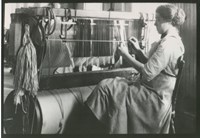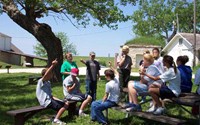- Lesson Plan (1,291)
- Field Trips (420)
- Distance Learning (301)
- Student Activities (247)
- Traveling Trunk (91)
- Teacher Reference Materials (72)
- Other Education Materials (64)
- Guest Speakers (52)
- Primary Sources (29)
- Science Labs (14)
- Media for Loan (13)
- Field Schools & Institutes (10)
- Teacher Workshops & Other Programs (7)
- Online Galleries (4)
- Teacher-Ranger-Teacher (3)
- Acadia National Park (130)
- Glacier National Park (90)
- Cowpens National Battlefield (72)
- Everglades National Park (66)
- Gateway Arch National Park (55)
- Olympic National Park (50)
- Fort Scott National Historic Site (44)
- Haleakalā National Park (44)
- Sleeping Bear Dunes National Lakeshore (39)
- Show More ...
- Social Studies (1,551)
- Science (1,212)
- Literacy and Language Arts (712)
- Math (253)
- Upper Elementary: Third Grade through Fifth Grade (1,153)
- Middle School: Sixth Grade through Eighth Grade (769)
- Lower Elementary: Pre-Kindergarten through Second Grade (300)
- High School: Ninth Grade through Twelfth Grade (279)
- Adult Education (25)
- Graduate Level (Masters (3)
- PhD) (3)
- College Undergraduate Level (2)
Showing 2,531 results for hydrology science and learning ...
Learn at the Ledges
- Type: Field Trips
- Grade Levels: Upper Elementary: Third Grade through Fifth Grade
Yellowstone Distance Learning
Science on the Prairie
Learning about the Homestead Act
Heading West? (Distance Learning)
- Type: Distance Learning
- Grade Levels: Lower Elementary: Pre-Kindergarten through Second Grade
Lewis and Clark (Distance Learning)
- Type: Distance Learning
- Grade Levels: Upper Elementary: Third Grade through Fifth Grade

Students in this distance learning program will learn about the Corps of Discovery's expedition to the Pacific Coast from St. Louis, a round trip that took three years to complete between 1803 and 1806. They will also learn about the lives of Lewis and Clark and the people they interacted with during the expedition.
Learning from Spanish Coins
- Type: Lesson Plan
- Grade Levels: Upper Elementary: Third Grade through Fifth Grade

In this lesson, students learn about 18th-century Spanish currency. Teachers can use the lesson plan to help their students investigate how archeologists use artifacts like coins to come up with a relative date for an archeological site. Students will understand how archeologists use newer technologies, such as 3D modeling and Virtual Reality, in order to analyze and interpret artifacts and objects.
Lessons Learned In West Branch
- Type: Field Trips ... Student Activities
- Grade Levels: Upper Elementary: Third Grade through Fifth Grade
Distance Learning: A Beneficial Fire
- Type: Distance Learning
- Grade Levels: Middle School: Sixth Grade through Eighth Grade

This distance learning opportunity explores prescribed fires. Ranger will walk students through the benefits of a prescribed fire, particularly within the prairie restoration process. Students will learn about equipment, personal protective equipment, and possible NPS careers in wildland fire management.
War of 1812 Learning Module
- Type: Teacher Reference Materials
- Grade Levels: Upper Elementary: Third Grade through Fifth Grade
This reference packet for teachers includes worksheet templates for independent and guided activities utilizing a cross-curricular approach to learning. Activities can be modified to meet the needs of your group. Includes guided primary source research, graphing, writing and literacy activities.
Let's Learn About Seeds
- Type: Lesson Plan
- Grade Levels: Lower Elementary: Pre-Kindergarten through Second Grade

"Let's Learn About Seeds" introduces students to seeds, the four plant growth stages, and the different conditions needed for growth. This is a great post-Virtual Field Trip lesson plan that helps reinforce topics discussed during the virtual program or can be done as a standalone lesson plan. Please email cocanaleducation@nps.gov about scheduling a Virtual Field Trip with the C&O Canal National Historical Park.
Environmental Prairie Science
The Science of Sled Dogs
- Type: Distance Learning
- Grade Levels: Upper Elementary: Third Grade through Fifth Grade

Did you know that park rangers use sled dogs to perform winter work in Denali National Park and Preserve? But why? Join us to learn about why these amazing animals are perfectly adapted to a cold, subarctic environment. Take a deeper dive into what makes the tails, fur, feet, and dispositions of Denali’s sled dogs so good for their snowy, hard work!
Introduction to Citizen Science
- Type: Lesson Plan
- Grade Levels: Middle School: Sixth Grade through Eighth Grade

Citizen Science is the involvement of everyday people in making scientific observations of the world around us. These observations address real world problems and contribute to scientific research projects. Citizen Science initiatives provide opportunities for the public to collect data in the field and report findings to databases used by professional scientists. Introduce your students to this growing field, in which amateur scientists can contribute meaningful observations to science.
Illustrate Your Service Learning Project
Park Rangers Protect, Learn, and Explore
- Type: Field Trips
- Grade Levels: Lower Elementary: Pre-Kindergarten through Second Grade
At Cowpens National Battlefield, the teacher reads information about national parks and the job of park rangers. Students will learn how the actions of humans can affect the survival of plants and animals, and will also learn how they can participate in the Junior Ranger and WebRanger programs!
Bison Banquet - Distance Learning Program
- Type: Distance Learning
- Grade Levels: Upper Elementary: Third Grade through Fifth Grade
Looming and Learning: Threading the Past and Present
- Type: Lesson Plan
- Grade Levels: Middle School: Sixth Grade through Eighth Grade

How many clothes do you own? Are any of them handmade? Why don't people tend to hand make their clothing at home anymore? This lesson will investigate our complicated relationship with something as simple as thread. Old Slater Mill was the first successful water-powered cotton spinning mill in North America. This place transformed the relationship US citizens had with their clothing. This hands-on activity investigates how our relationship with clothing has changed over the past 230 years.











